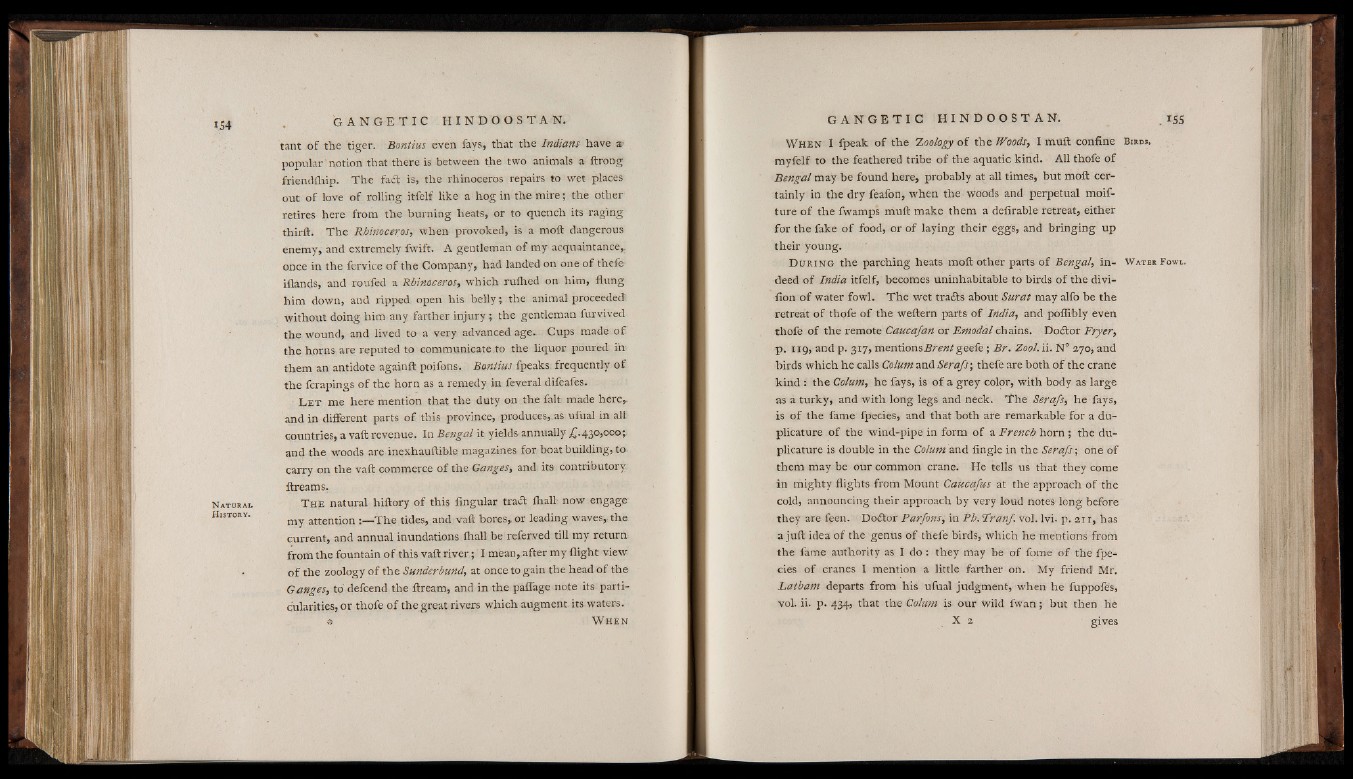
tant o f the tiger. Bontius even fays, that the Indians have &
popular notion that there is between the two animals a ftrong
friendihip. The fact is, the rhinoceros repairs to wet places
out o f love of rolling itfelf like a hog in the mire; the other
retires here from the burning heats, or to quench its raging
thirft. The Rhinoceros, when provoked, is a moft dangerous
enemy, and extremely fwift. A gentleman o f my acquaintance,,
once in the fervice of the Company, had landed on one of thefe
iilands, and roufed a Rhinoceros, which ruihed on him, flung
him down, and ripped open his belly; the animal proceeded-
without doing him any farther injury ; the gentleman furvived
the wound, and lived to a very advanced age. Cups made o f
the horns are reputed to communicate,to the liquor poured in
them an antidote againft poifons. Baniius fpeaks frequently of
the fcrapings of the horn as a remedy in feveral difeafes.
L e t me here mention that the duty on the fait made here,,
and in different parts o f this province, produces,.as ufnal in all
countries, a vaft revenue. In Bengal it yields annually £.430,000;
and the woods are inexhauftible magazines for boat building, to
carry on the vaft commerce o f the Ganges, and its contributory
ftreams,
N a tu r a l T h e natural hiftory o f this Angular trail fhall- now engage
His to r y . _ attention 'The tides, and vaft bores,, or leading waves,, the
current, and annual inundations ihall be referved till my return
from the fountain o f this vaft riv e r ; I mean,after my flight view
o f the zoology o f the Sunderbund, at once to gain the head o f the
Ganges, to defcend the ftream, and in the paffage note its particularities,
or thofe o f the great rivers which augment its waters.
» W hen
W hen I fpeak o f the Z oology o f the Woods, I muft confine
myfelf to the feathered tribe o f the aquatic kind. All thofe o f
Bengal may be found here, probably at all times, but moft certainly
in the dry feafon, when the woods and perpetual moif-
ture o f the fwamps muft make them a defirable retreat, either
for the fake o f food, or o f laying their eggs, and bringing up
their young.
D u r i n g the parching heats moft other parts of Bengal, indeed
of India itfelf, becomes uninhabitable to birds of the divi-
fion o f water fowl. The wet trails about Surat may alfo be the
retreat of thofe of the weftern parts of India, and poflibly even
thofe of the remote Caucafan or Emodal chains. Doilor Fryer,
p. 119, and p. 317, mentions Brent geete; Br. Zool. ii. N° 270, and
birds which he calls Colum and Sera/s; thefe are both o f the crane
kind : the Colum, he fays, is of a grey color, with body as large
as a turky, and with long legs and neck. The Serafs, he fays,
is of the fame fpecies, and that both are remarkable for a du-
plicature o f the wind-pipe in form of a French horn ; the du-
plicature is double in the Colum and fingle in the Serafs; one of
them may be our common crane. He tells’ us that they come
in mighty flights from Mount Caucafus at the approach of the
cold, announcing their approach by very loud notes long before
they are feen. Dodlor Parfons, in PA. Tranf vol. Ivi. p. 211, has
a juft idea o f the genus of thefe birds, which he mentions from
the fame authority as I do : they may be o f fome o f the fpecies
of cranes I mention a little farther on. My friend Mr.
Latham departs from his ufual judgment, when he fuppofes,
vol. ii. p. 434, that the Colum is our wild fwan; but then he
X 2 gives
B irds.
W a t e r F owl.